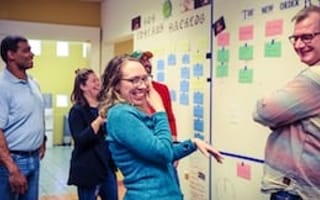
Company culture is high on Joel Grossman’s priority list. As CTO of Leapfrog Online, he and his team’s core product is an e-commerce marketing platform that helps retailers sway consumers making high-consideration purchases — a herculean undertaking that requires close collaboration between engineers, product experts and end users.
In Grossman’s view, looking exclusively for people who already have domain expertise can cause a company to miss out on great employees. Instead, his team focuses on hiring the right people early and supporting them as they hone their skill sets.
Which technologies power your business?
Our stack is powered by open-source technologies. Our foundation is built on CentOS, Nginx, Postgres, Redis and Rabbit MQ. We write internal and consumer-facing applications in Ruby, Python and JavaScript with Rails, Django and React, respectively. We strongly subscribe to “use the right tool for the right job,” and we’re not dogmatic about what tools should be used — teams have autonomy in implementing the solutions that they see fit.
What are the biggest technology projects you’re working on this year?
Our platform delivers real-time personalization of high-consideration e-commerce purchases at scale. It also connects data from disparate sources to enable rich visualization and analytics. Leapfrog’s platform starts from the assumption that we’ll need to integrate a variety of different application and data sources to create a closed loop of data for our clients’ marketing activity, so we continue to scale both of these capabilities.
We’re also working to understand how different categories of information can augment today’s rule-driven and predictive conversion optimization techniques, and we’re moving to an even more dynamic personalization method driven by levels of behavioral, consumer and demographic data. Doing so in real time is a challenging engineering problem to solve.
We’re also scaling our ability to do more robust statistically-driven personalization in real time, based on the likelihood of a consumer to convert, which involves combinations of statistical model-driven development and machine learning.
Finally, we’re moving decisively to a cloud-based infrastructure this year, after spending a good amount of time comparing cloud providers and performing a series of prototypes and feature comparisons.
What are the most important tech developments you’re watching right now?
At the infrastructure level, we’ve spent a long time evaluating movements in cloud computing. While the feature battles continue between Google Compute, AWS and Azure, active innovation is rapidly changing how software is developed, deployed and used. We take a long-term view of that evolution, looking for flexibility and scalability that can reduce the cost of operating our platform. But we’re cautions not to lose the levels of monitoring, provisioning and low-level introspection of processes that come along with cloud and container-based approaches.
At the software level, programming languages like Elixir, Rust and Go offer some very interesting advances in performance, concurrency and power. The advances of languages like Python and Ruby over commercial internet-defining languages like Perl, PHP and Java demonstrate that there’s room for new languages and approaches.
We’re also looking at advances in machine learning, augmented reality and voice interface devices like Alexa and Google Home. Given our recent acquisition by Dentsu Aegis Network, there are new opportunities in managing data sets and building predictive models. We have access to a world-class set of information resources across range of digital advertising and marketing domains and industries, especially around digital-to-offline behavior.
What sets your team apart?
Our core values — learning, transparency and inclusivity — create a solid cultural foundation and sense of community within our team. Those values are made tangible through things like curriculum development, lightning talks, a weekly open forum for the entire technology team, training around unconscious bias, blind hiring practices and working with organizations like Black Girls Code and PyLadies. It also means maintaining safe environments where folks feel comfortable admitting challenges and asking for help.
Our talent identification and development process is also a differentiator. We prefer to find promising people in earlier stages of their career, or people from non-traditional backgrounds, and help them develop as technical leaders. Leapfrog offers formal apprenticeships for both engineering and product roles — a multi-disciplinary program that attracts new-to-technology talent ready to occupy junior roles. We especially focus on developing talent in underrepresented communities. A diverse work environment is better on both ethical and pragmatic grounds; diversity of background and thought process enables higher-performing teams.
What do you look for when hiring for engineers?
Self-awareness is one of the most critical traits we seek. While technical skill is critical for any engineer, is has to be balanced against soft skills and the ability to work within the interpersonal ecosystem of teams. We’ve found that self-awareness creates an excellent foundation on which to build and expand soft skills in tandem with technical skill.
During the hiring process, candidates meet not only with their potential engineering colleagues, but with product owners, scrum masters and users of our platform. We want to ensure that the candidates get a sense for the overall environment before joining the team.
Image via Leapfrog Online.
What's your company's story? Let us know with a tip or a tweet @BuiltInChicago






